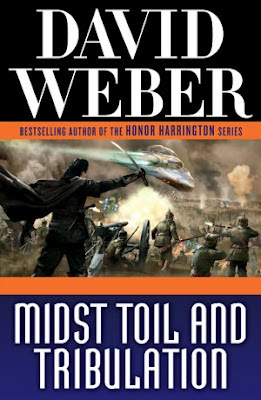INTRODUCTION: Scottish sf writer Gary Gibson burst onto the scene in 2004 with a very ambitious debut Angel Stations which made me a big time fan. While having some debut flaws like lack of balance and even too much ambition for the relatively limited page count, Angel Stations is not your "average" debut, but a very complex and mature novel that pays several close readings. His second novel, Against Gravity, quite different in tone was another hit with me and then turning his hand to "popular" new space opera on a galactic canvas and with all the associated paraphernalia, Mr. Gibson completed the Shoal trilogy of which its debut Stealing Light was my top sf novel of the year.
While planning a return to the Shoal universe at some point, Gary Gibson developed another fascinating universe, "The Founder Network" one - in the 22/23 rd centuries humanity develops wormhole based ftl, only to find a sophisticated ancient system of wormholes, built by the hypothetical aliens named "Founders", system that goes far away in space and time but comes with potentially major dangers as we learn in Final Days.
OVERVIEW/ANALYSIS: The Thousand Emperors is set in the same universe with Final Days some centuries after the events there and while there are some cool references to it at some point and of course the Founder network and tech is important even indirectly, the book is really a standalone as everything needed is explained.
As structure, the novel is part action adventure, part investigation of the powerful with the attending risks, part sense of wonder all written in the wonderful style that made Gary Gibson one of the top sf authors of today with all 7 books to date read by me the moment I got them, either on publication or occasionally as advanced reading copies.
Most of The Thousand Emperors takes place in Tian Di, a semi paternalistic space empire modeled on the successful semi-democratic Asian states of today like Singapore - led by a council of elders that achieved effective immortality with clones and transcribing personality, protected by an elite force of warriors - the Sandoz - who also benefit by the same treatments.
Separated a few centuries ago from the Western-like Coalition after a successful revolution on its worlds and the severance of the wormholes connecting Tian Di's worlds with the Coalition, Tian Di's people enjoy generally tranquil and prosperous lives but there are some trouble spots and then there is what some perceive as stagnation with science and technology managed by the Council, while the Coalition is rumored to be leaps and bounds ahead.
So despite Joseph "Father" Cheng's wishes - the leader of the Council though not without internal opposition - and even of most of the 85 "inner" members of the Council, there is a seemingly inevitable "reunification" with the Coalition with the first wormhole connecting Tian Di's capital Temur to Darwin the Coalition's capital to be opened soon.
Explaining this better here is an excerpt from the Prologue, which in pure sf tradition is itself a purported "Excerpt from A History of the Tian Di: Volume 1 – From Abandonment to Schism by Javier Maxwell."
"The decades following the Abandonment were hard, lean times, but barely half a century later starships carrying new, retro-engineered transfer gates were already being sent out to reconnect the colonies one to another. It is in this period that the template for the modern political order was laid down.
Although the Western Coalition – by this time, simply the Coalition – had seized political and military control of the colonial governments, the general populations of those worlds had been predominantly drawn from member nations of the former Asian Co-Prosperity Sphere. Coalition–Sphere relations were already deeply antagonistic prior to the Abandonment, and became more so, inevitably flowering into a full-fledged revolt a century after the Coalition’s takeover. The uprising proved to be bitter and protracted, but ended with several worlds finally achieving autonomy from Coalition rule. These worlds – Da Vinci (now Benares), Newton (now New Samarkand), Franklin (now Temur), Galileo (now Novaya Zvezda), Yue Shijie, and Acamar – became known collectively as the Tian Di, and were ruled from Temur by a council of revolutionary leaders numbering nearly a thousand. Although far from being a democracy, this Temur Council provided much-needed stability in the post-revolutionary period.
While the Tian Di and the Coalition co-existed in relative peace over the next several decades, they rapidly diverged both culturally and technologically. The Coalition first renewed and then stepped up its exploration of the Founder Network, despite increasingly alarmed protests from the Temur Council, whose members were afraid of a repeat of the events leading to the Abandonment. It is undoubted that the Temur Council lacked for effective leadership in the years immediately preceding what we now call the Schism, and the power vacuum following Salomón Lintz’s forced resignation as the Council’s Chairman offered a clear opportunity for a man as ruthlessly determined as Joseph Cheng. Cheng soon swept to power on the wave of a popular coup, and the promise that he would sever all transfer gates linking to the Coalition to prevent any possible repeat of the Abandonment. Cheng soon fulfilled his promise and, within days of becoming Permanent Chairman of the Temur Council, the human race was effectively split in two.
Those few members of the Temur Council who had openly opposed Cheng’s rise to power, including, most prominently, myself and Winchell Antonov, were either imprisoned, forced into exile, or executed on trumped-up charges. It cannot be denied that the period immediately following the Schism was marked by unprecedented peace throughout the Tian Di. The quality of life for our citizens improved by such leaps and bounds that there was, for a long time, little to no demand throughout the Tian Di for moves towards more democratic representation.
The one real exception, of course, was Benares – a world of limited resources, cruelly under-represented within the Council. It was on Benares that Winchell Antonov, having escaped his imprisonment, founded the Black Lotus organization. Antonov is also credited with giving Cheng’ls Council the less than flattering sobriquet The Thousand Emperors."
Although the Western Coalition – by this time, simply the Coalition – had seized political and military control of the colonial governments, the general populations of those worlds had been predominantly drawn from member nations of the former Asian Co-Prosperity Sphere. Coalition–Sphere relations were already deeply antagonistic prior to the Abandonment, and became more so, inevitably flowering into a full-fledged revolt a century after the Coalition’s takeover. The uprising proved to be bitter and protracted, but ended with several worlds finally achieving autonomy from Coalition rule. These worlds – Da Vinci (now Benares), Newton (now New Samarkand), Franklin (now Temur), Galileo (now Novaya Zvezda), Yue Shijie, and Acamar – became known collectively as the Tian Di, and were ruled from Temur by a council of revolutionary leaders numbering nearly a thousand. Although far from being a democracy, this Temur Council provided much-needed stability in the post-revolutionary period.
While the Tian Di and the Coalition co-existed in relative peace over the next several decades, they rapidly diverged both culturally and technologically. The Coalition first renewed and then stepped up its exploration of the Founder Network, despite increasingly alarmed protests from the Temur Council, whose members were afraid of a repeat of the events leading to the Abandonment. It is undoubted that the Temur Council lacked for effective leadership in the years immediately preceding what we now call the Schism, and the power vacuum following Salomón Lintz’s forced resignation as the Council’s Chairman offered a clear opportunity for a man as ruthlessly determined as Joseph Cheng. Cheng soon swept to power on the wave of a popular coup, and the promise that he would sever all transfer gates linking to the Coalition to prevent any possible repeat of the Abandonment. Cheng soon fulfilled his promise and, within days of becoming Permanent Chairman of the Temur Council, the human race was effectively split in two.
Those few members of the Temur Council who had openly opposed Cheng’s rise to power, including, most prominently, myself and Winchell Antonov, were either imprisoned, forced into exile, or executed on trumped-up charges. It cannot be denied that the period immediately following the Schism was marked by unprecedented peace throughout the Tian Di. The quality of life for our citizens improved by such leaps and bounds that there was, for a long time, little to no demand throughout the Tian Di for moves towards more democratic representation.
The one real exception, of course, was Benares – a world of limited resources, cruelly under-represented within the Council. It was on Benares that Winchell Antonov, having escaped his imprisonment, founded the Black Lotus organization. Antonov is also credited with giving Cheng’ls Council the less than flattering sobriquet The Thousand Emperors."
Coming back to the book itself, the story follows "master archivist" security investigator Luc Gabion whom we see (nominally) leading a Sandoz strike force closing in the last hideout of Winchell Antonov, hideout that was found by Gabion's painstaking investigation of years. The book just explodes from its first "proper" page - after the prologue quoted above - and it just does not stop for over 300 pages that "demand" end to end reading, so absorbing they are.
"‘Gabion.’
Luc turned to see Marroqui stabbing a finger at him from across the hold, his face dimly visible within his helmet.
‘Close your visor, Goddamn it,’ said Marroqui, his voice flat and dull in the cramped confines of the hold. ‘Depressurization in less than thirty seconds. We’re landing.’
Luc reached up and snapped his helmet’s visor into place, ignoring the smirking expressions of the armour-suited Sandoz warriors arrayed in crash couches around him. They were crammed in close to each other, bathed in red light."
Luc turned to see Marroqui stabbing a finger at him from across the hold, his face dimly visible within his helmet.
‘Close your visor, Goddamn it,’ said Marroqui, his voice flat and dull in the cramped confines of the hold. ‘Depressurization in less than thirty seconds. We’re landing.’
Luc reached up and snapped his helmet’s visor into place, ignoring the smirking expressions of the armour-suited Sandoz warriors arrayed in crash couches around him. They were crammed in close to each other, bathed in red light."
There are a lot of nice touches - eg Tian Di seems very "real" reflecting the author's true experiences (meaning doing real work and mingling with the local population not only with the bigwigs in flyby "research" trips...) of living in the east, the sense of wonder is vivid and the action feels mostly "realistic" too with few over the top moments.
There are also a few quieter moments and the characters "have also lives", the lack of which is one the main failings of action-adventure sf...
"Luc arrived back at his apartment without incident and found several messages waiting for him from Eleanor. This time, instead of ignoring them he sent back an immediate response. He had a sudden desperate urge to see her, to hold her in his arms."
The one negative of the book is the lack of ambiguity in the main villains who after a while are quite easy to pinpoint as they almost wear the well known "villain hat", while also being real unsubtle about it as in an emphatic "I am in for me", but I mind this much less in sf than in fantasy and the novel delivers so well in all the other aspects (action, sense of wonder, world building, characters, style...) that this niggle is quite minor.




























